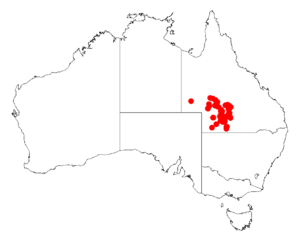Acacia ensifolia facts for kids
Quick facts for kids Acacia ensifolia |
|
|---|---|
| Conservation status | |
| Scientific classification | |
| Genus: |
Acacia
|
| Species: |
ensifolia
|
 |
|
| Occurrence data from AVH | |
Acacia ensifolia is a type of tree that belongs to the Acacia family. It is found only in Queensland, Australia.
About the Acacia ensifolia Tree
This tree can grow quite tall, up to 9 meters (about 30 feet)! It often has many stems and a wide, spreading top, like a big umbrella.
Its leaves are special. They are called phyllodes, which are flattened leaf stems that look like leaves. These phyllodes are grey-green to green and hang down. They are long and narrow, usually 15 to 27 centimeters (6 to 10.5 inches) long and 3 to 8 millimeters (0.1 to 0.3 inches) wide. You can see a clear line down the middle and along the edges.
When the tree flowers, it has bright yellow, round flower-heads. These flower-heads are about 7 to 8 millimeters (0.2 to 0.3 inches) wide and are packed with 50 to 60 tiny flowers. They grow in groups of 10 to 15.
After the flowers, the tree grows seed pods. These pods are firm and smooth, with a white, dusty coating. They can be up to 13 centimeters (5 inches) long and 10 to 18 millimeters (0.4 to 0.7 inches) wide. Inside the pods, you'll find shiny, blackish seeds that are round or oval shaped.
How Scientists Classify Acacia ensifolia
Scientists use a system called taxonomy to name and group living things. The Acacia ensifolia was first officially described by a botanist named Leslie Pedley in 1969. He wrote about it in a scientific paper called Notes on Acacia, chiefly from Queensland.
Later, in 1986, Pedley changed its classification to Racosperma ensifolium. But then, in 2006, it was moved back to the Acacia group.
Acacia ensifolia looks very similar to another tree called Acacia pruinocarpa, which grows further west. It also looks a bit like Acacia beckleri.
Where Acacia ensifolia Grows
This tree is found in a small part of South West Queensland, Australia. Most of these trees grow on and around an area called the Gray Range. You can also find them scattered in places like Adavale to the north and near Thargomindah to the south.
They usually grow on low hills in clay loam soils. These trees are part of the mulga shrubland communities, which are areas with many small trees and shrubs. They are also found along the eastern edge of the Simpson Desert ecoregion.


